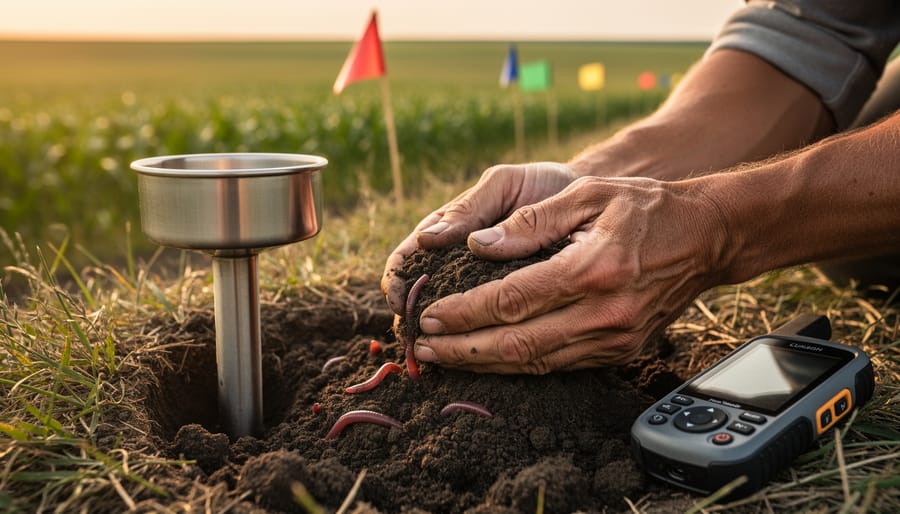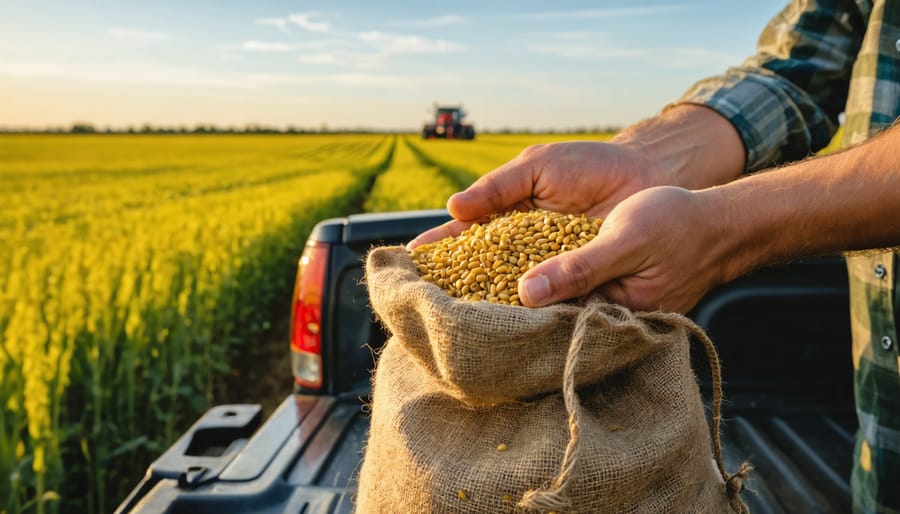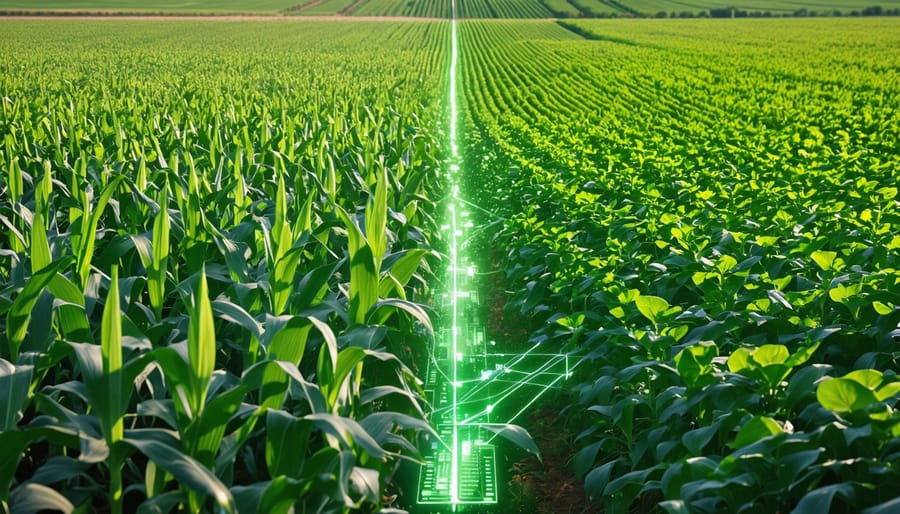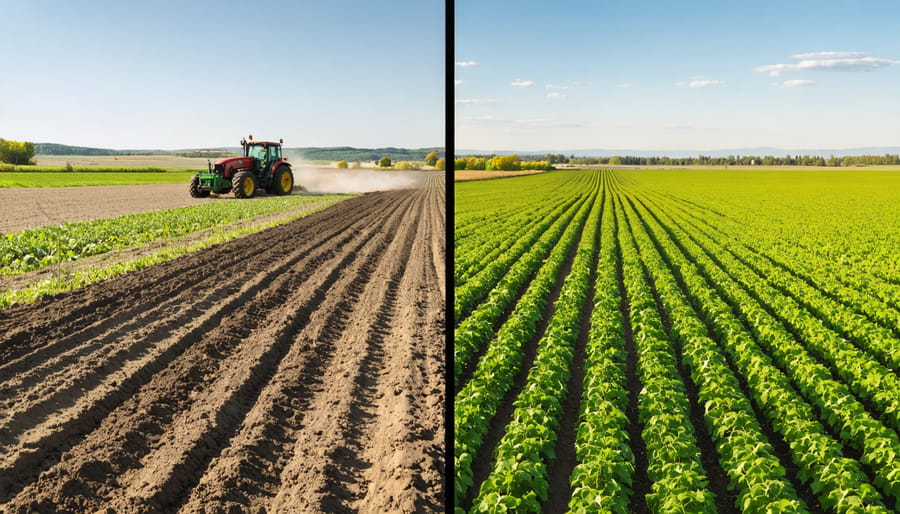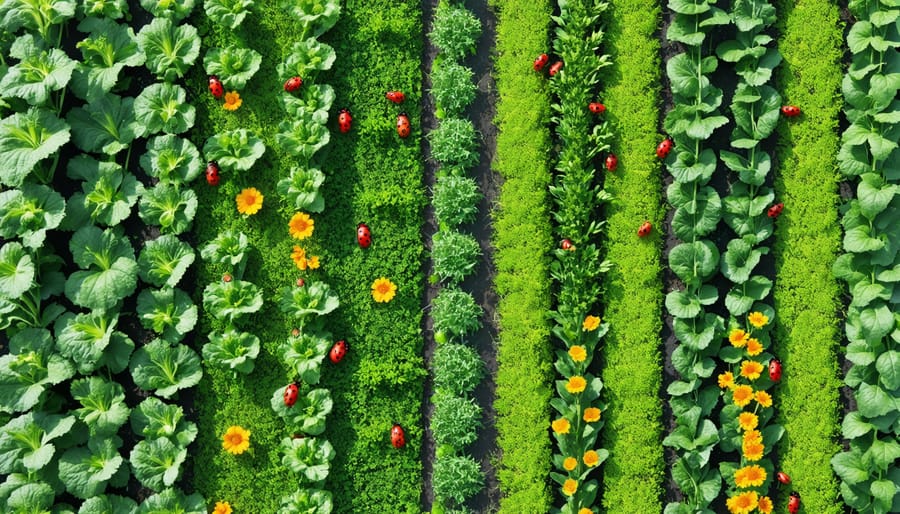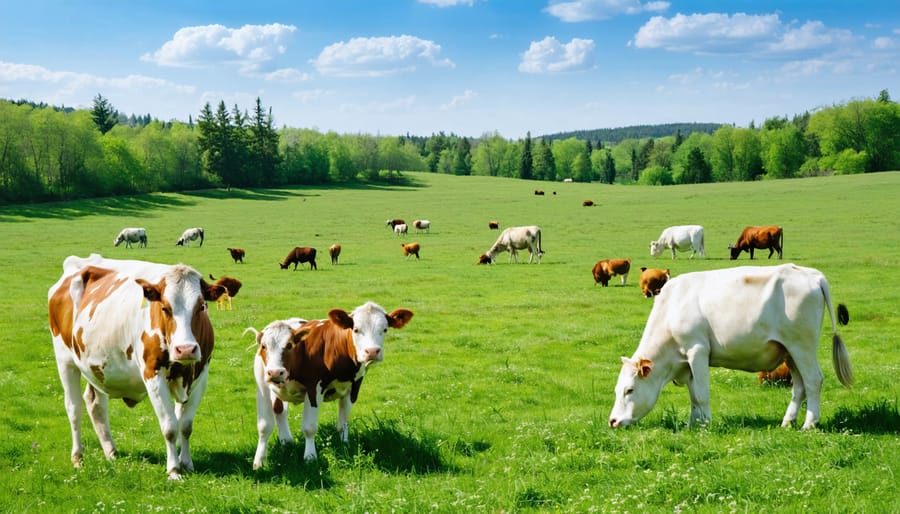Organic farming’s rising challenges in Alberta’s agricultural landscape demand a critical reassessment of our long-held assumptions about sustainability. While organic methods promise environmental benefits, mounting evidence suggests these practices may struggle to meet Canada’s growing food security needs. Recent data from Agriculture and Agri-Food Canada reveals organic farms typically yield 20-30% less than conventional operations while requiring significantly more land and water resources per unit of production. For Alberta’s farmers, who steward over 50 million acres of agricultural land, this efficiency gap represents not just an economic challenge, but a fundamental sustainability concern. The complexities of organic certification, combined with increasing climate pressures and market demands, have created a perfect storm that threatens the viability of purely organic systems. However, this reality check doesn’t signal the end of organic farming – rather, it calls for a thoughtful integration of sustainable practices that combine the best of organic principles with modern agricultural innovations. As we navigate these challenges, our focus must shift toward developing hybrid solutions that maintain environmental stewardship while ensuring robust food production for future generations.
The Real Cost of Current Organic Standards
Yield Gaps and Economic Viability
Research conducted across Alberta’s farming regions reveals significant yield gaps between organic and conventional farming methods. According to a comprehensive study by the University of Alberta, organic crop yields typically range between 20-30% lower than conventional yields, with variations depending on crop type and local conditions.
For wheat production, organic farms in southern Alberta averaged 2.1 tonnes per hectare compared to 3.3 tonnes per hectare in conventional systems. Similar patterns emerged for canola, where organic yields reached 1.4 tonnes per hectare versus 2.2 tonnes in conventional farming.
These yield differences directly impact farm economics. While organic products command premium prices – often 30-50% higher than conventional – the reduced yields and increased labour costs can offset these gains. A 2022 economic analysis of Alberta farms showed that organic operations required approximately 35% more labour hours per hectare and faced higher risks during challenging weather conditions.
However, some innovative Alberta farmers are narrowing this gap through improved organic practices. For instance, the integration of cover crops and advanced rotation systems has helped several operations achieve yields within 15% of conventional levels. These success stories demonstrate that while yield gaps persist, they can be managed through optimization of organic methods and careful attention to soil health management.
The key to economic viability lies in balancing these yield considerations with market opportunities and operational efficiencies specific to each farm’s context.

Resource Intensity Paradox
While organic farming aims to be environmentally friendly, it sometimes requires more resources than conventional methods – a situation we call the resource intensity paradox. For example, mechanical weed control in organic fields often requires multiple passes with tractors, consuming more fuel than a single herbicide application. In Alberta’s dry prairie regions, organic farmers typically need to till their fields more frequently for weed management, which can lead to increased soil erosion and moisture loss.
Water usage presents another challenge. Without synthetic fertilizers, organic crops may need more irrigation to achieve comparable yields. Local studies from the University of Alberta show that organic potato farming can require up to 20% more water than conventional methods to maintain similar production levels.
Land use efficiency is also a significant consideration. Because organic farming typically produces lower yields per hectare, more land is needed to grow the same amount of food. In the Calgary region, organic grain farmers often require 1.3 to 1.5 times more land area compared to conventional farms for equivalent production.
However, these resource challenges aren’t insurmountable. Many Alberta farmers are implementing innovative solutions like precision agriculture tools, advanced crop rotation systems, and water-efficient irrigation methods to optimize resource use while maintaining organic certification. The key is finding the right balance between organic principles and practical resource management.
Land Use Efficiency Crisis
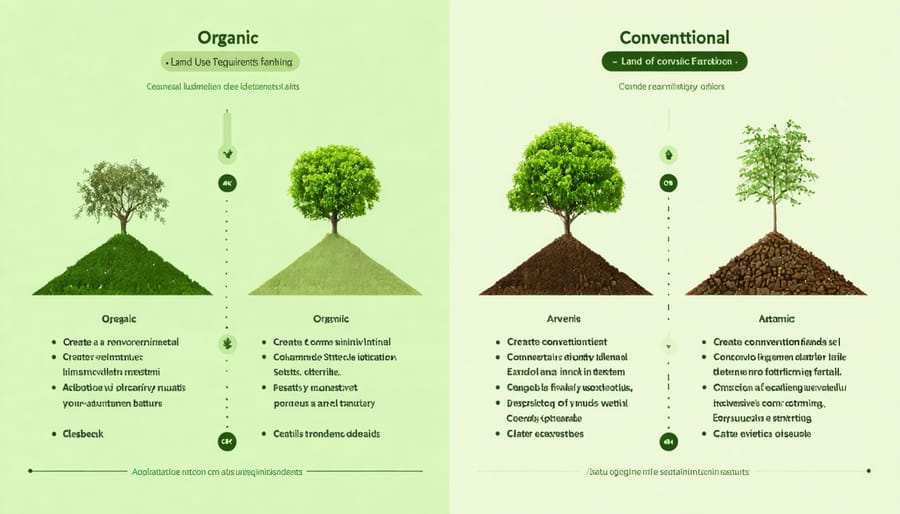
Alberta’s Land Availability Challenge
Alberta’s vast agricultural landscape presents a unique challenge when considering the transition to organic farming practices. While the province boasts approximately 50.3 million acres of farmland, organic farming typically requires 20-40% more land than conventional farming to produce equivalent yields. This spatial requirement stems from the need for crop rotation, buffer zones, and natural pest management areas.
Recent studies conducted by the University of Alberta show that if all farms in the province were to convert to organic methods, we would need an additional 15-20 million acres to maintain current production levels. This presents a significant land-use challenge, particularly in regions where agricultural expansion would impact natural habitats or protected areas.
Local farmer James McKenzie, who operates a mixed farm near Red Deer, shares his experience: “Converting to organic meant adjusting our production goals. We had to dedicate more land to green manure crops and establish natural barriers between our fields and conventional farms nearby.”
The land availability challenge has sparked innovative solutions within the farming community, including intensive organic methods, vertical farming integration, and collaborative land-sharing initiatives. These approaches help maximize productivity while working within existing land constraints, demonstrating that while space requirements present challenges, adaptation and innovation continue to drive the sector forward.
Environmental Impact Assessment
The expansion of organic farming presents unique environmental challenges that warrant careful consideration. While organic practices aim to promote biodiversity, research from the University of Alberta suggests that converting conventional farmland to organic production could require up to 40% more land to achieve similar yields. This increased land requirement poses significant risks to natural habitats and wildlife corridors across Alberta’s diverse landscape.
A recent study in southern Alberta demonstrated that converting 1,000 hectares of conventional farmland to organic production would necessitate clearing an additional 400 hectares of natural areas to maintain current production levels. This expansion particularly threatens native grasslands, which support numerous endangered species and play a crucial role in carbon sequestration.
However, innovative approaches are emerging to address these challenges. Many Alberta farmers are implementing intensive organic methods that maximize yield per hectare through techniques like vertical growing and precision agriculture. The Prairie Organic Development Fund reports that farms using these methods have reduced their land requirements by up to 25% compared to traditional organic operations.
Finding the right balance between organic practices and land conservation remains crucial for maintaining both agricultural productivity and environmental integrity in our region.
Bridging the Gap: Hybrid Solutions
Regenerative Agriculture Alternatives
Several Alberta farmers have successfully implemented hybrid approaches combining conventional and regenerative agriculture practices to create more sustainable operations. The Thompson family farm near Red Deer showcases how integrating cover crops and reduced tillage with selective conventional methods has improved soil health while maintaining profitable yields. Their five-year transition demonstrated a 30% reduction in input costs while maintaining 90% of their previous production levels.
In Lacombe County, the Prairie Heritage Farm Collective has pioneered a community-supported hybrid farming model. By rotating between conventional crops and regenerative methods on different parcels, they’ve created a resilient system that protects against market fluctuations while building soil organic matter. Their soil testing shows a 40% increase in biological activity since implementing this approach three years ago.
The Mountain View Agricultural Society has documented success with their “smart transition” program, where farmers gradually introduce regenerative practices alongside existing conventional methods. This approach has helped 15 local farms reduce chemical inputs by an average of 25% while improving water retention capacity by 35%.
These examples demonstrate how combining traditional farming wisdom with modern regenerative techniques can create economically viable and environmentally sustainable agricultural systems suited to Alberta’s unique growing conditions.
Technology Integration
Modern technology is revolutionizing organic farming practices across Alberta, offering solutions that bridge the gap between traditional organic methods and efficient production. Smart sensors and precision agriculture tools now allow organic farmers to monitor soil health, moisture levels, and nutrient content in real-time, enabling more precise resource management while maintaining organic certification.
Alberta farmers are increasingly adopting drone technology for crop monitoring and targeted pest management. These aerial tools help identify problem areas early, reducing the need for broad-spectrum organic pesticides and minimizing crop losses. GPS-guided equipment ensures precise application of approved organic inputs and optimal spacing during planting, maximizing land use efficiency.
Advanced weather monitoring systems, coupled with AI-powered forecasting, help organic farmers make better-informed decisions about planting and harvesting times. This technology integration has shown promising results at several farms near Lethbridge, where producers have reported up to 20% improvement in crop yields while maintaining organic standards.
Automated weeding robots, specially designed for organic operations, are gaining traction. These machines use computer vision to distinguish between crops and weeds, providing mechanical weed control without chemical interventions. Local innovation hubs, like the Olds College Smart Farm, are testing these technologies in real-world conditions, helping farmers understand how to integrate them effectively into their organic operations.
By embracing these technological solutions, organic farmers can maintain their commitment to sustainable practices while improving operational efficiency and economic viability.

Moving Forward: Practical Solutions
Standard Reform Proposals
Several agricultural experts and farmer advocacy groups have proposed updates to the Canadian organic standards to address sustainability concerns while maintaining the core principles of organic farming. These proposals focus on integrating modern sustainable practices with traditional organic methods.
Key recommendations include allowing controlled use of specific synthetic nutrients when soil tests demonstrate severe deficiencies, particularly in phosphorus and micronutrients. This approach would help prevent long-term soil degradation while maintaining organic integrity. Another significant proposal involves implementing a tiered certification system that recognizes different levels of organic practices, making the transition more manageable for conventional farmers.
Alberta-based agricultural researchers suggest incorporating precision farming technologies within organic frameworks to optimize resource use. This includes utilizing soil sensors, weather monitoring systems, and GPS-guided equipment to reduce waste and improve efficiency.
Additional proposals focus on updating crop rotation requirements to better suit regional conditions, particularly in prairie provinces where traditional rotation patterns may not be optimal. These changes would allow farmers to adapt to local climate challenges while maintaining soil health.
The reforms also emphasize the need for clearer guidelines on carbon sequestration practices and water conservation methods, reflecting growing concerns about climate resilience in Canadian agriculture. These updates would help organic farmers better contribute to environmental sustainability while maintaining productive operations.
Local Adaptation Strategies
Alberta’s unique climate and soil conditions require farmers to develop specialized approaches when transitioning from conventional to organic methods. While sustainable farming practices in Alberta continue to evolve, successful adaptation strategies often combine traditional knowledge with innovative solutions.
Local farmers have found success by implementing extended crop rotations that include drought-resistant varieties and nitrogen-fixing legumes suited to the prairie climate. Many have adopted integrated pest management systems that utilize beneficial insects native to the region, reducing the need for organic pesticides while maintaining crop health.
Water conservation plays a crucial role in Alberta’s organic farming landscape. Producers are incorporating moisture-retention techniques such as reduced tillage and strategic cover cropping, particularly important during the province’s characteristically dry periods. Some farmers have reported success with precision irrigation systems that optimize water usage while maintaining organic certification requirements.
Soil building has emerged as a key focus, with producers developing region-specific composting programs that utilize local agricultural by-products. Many operations have established partnerships with nearby livestock farms to secure reliable sources of organic matter for soil amendment.
Community knowledge-sharing networks have proven invaluable, with experienced organic farmers mentoring those in transition. These networks facilitate the exchange of practical solutions for common challenges, from frost protection strategies to marketing approaches that resonate with local consumers. Through these collaborative efforts, Alberta’s organic farming community continues to build resilience and adapt to changing conditions.
As we’ve explored throughout this discussion, the challenges facing organic farming in Alberta are significant but not insurmountable. While current organic practices may struggle with scalability and resource efficiency, innovative solutions are emerging that combine the best of organic principles with practical sustainability measures.
The path forward lies in adopting a balanced approach that incorporates sustainable practices while acknowledging the realities of modern agricultural demands. Many Alberta farmers are already leading the way by implementing hybrid systems that maintain soil health and biodiversity while achieving necessary production levels through carefully selected conventional methods.
Looking ahead, the future of sustainable agriculture in our region will likely embrace a more nuanced approach. This includes integrating precision farming technologies, developing better organic pest management solutions, and implementing water-efficient irrigation systems. The key is finding the sweet spot between environmental stewardship and economic viability.
For Alberta’s farming community, success will come from staying informed, sharing experiences, and remaining adaptable to new research and technologies. Local agricultural extension services and farmer networks continue to provide valuable resources and support for those navigating these changes.
Remember, sustainability isn’t about choosing between organic and conventional farming – it’s about creating resilient agricultural systems that work for our unique landscape, climate, and community needs. By working together and staying open to evolving practices, we can build a more sustainable agricultural future for Alberta.


